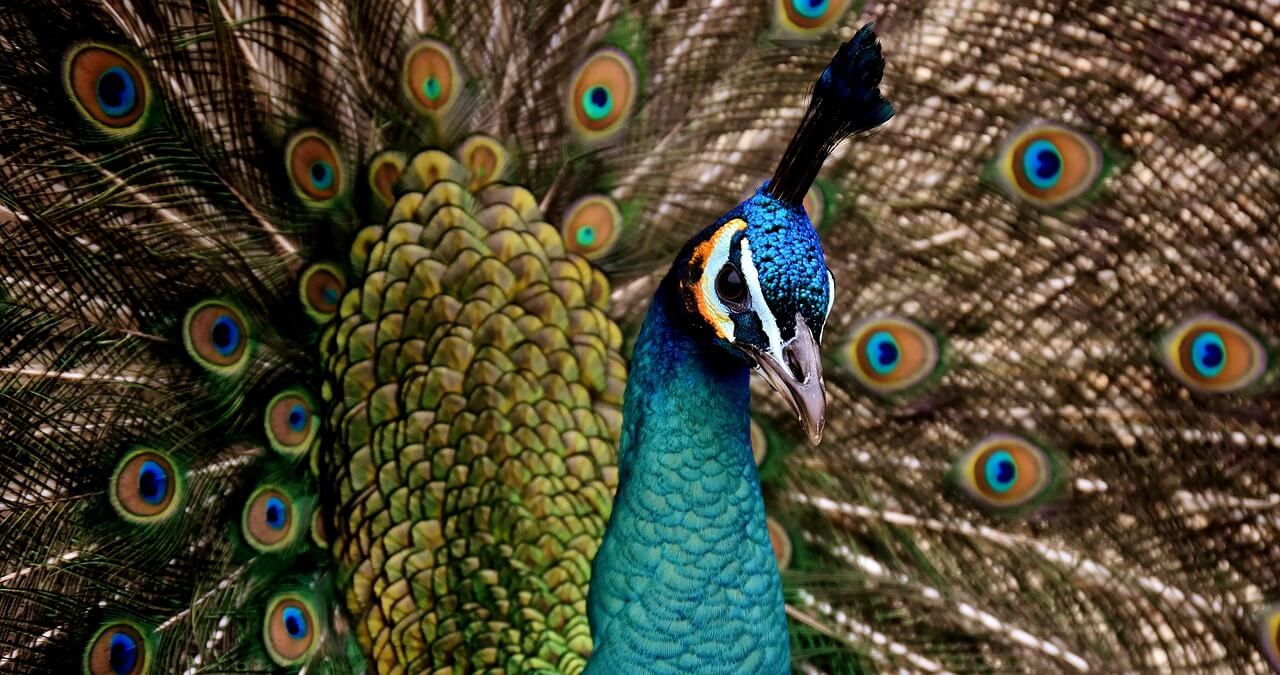Peacocks are famous for their stunning feathers, and while the traditional green and blue varieties are well-known, peacocks have some truly extraordinary and less-known species. And among these, the purple and red peacocks are unique examples of nature.
So, with that said, in this blog post, we will provide an overview of purple peacocks and red peacocks. This blog will include the appearances of peacocks, some interesting facts, and the symbolism associated with these beautiful birds. Are they real or rare? So, stay tuned. You’re going to explore the most exciting thing today!
Reason Behind The Peacock’s Colorful Look
When it comes to brilliant colors, peacocks are superior to other birds. Rather than depending just on pigments, peacocks also use photonic crystals to create their hues.
The distance between these crystals and the angle at which light strikes the feathers reflect different light wavelengths. This process gives peacocks their stunning range of hues, which resembles a mesmerizing rainbow.
Do Female Peacocks Have Bright Feathers?
Female peacocks, also known as peahens, have more muted appearances than their male counterparts. Their feathers are usually brown, tan, or grey, although they can also have iridescent patterns of blue or green. When nesting and raising their young, their pigmentation helps them blend in with their surroundings and protects them from predators.
However, the bright colors of male peacocks result from sexual selection. Peacocks with more elaborate and vibrant tails are more attractive to females because it is believed that these birds are in better condition, have higher genetic fitness, and can better protect and support their young.

Are Purple Peacocks Real?
Yes, they are accurate due to selective breeding and genetic mutation of Indian peafowl. They are rare in wildlife because they are not naturally occurring species. A Black shoulder peahen hatched the firstborn in 1987 in Arizona.
Where Do Purple Peacocks Originate?
These come from selective breeding practices among peafowl breeders. Breeders usually start with the Indian blue peafowl and manipulate genes to produce the unique purple plumage that makes these birds stand out.
Appearance Of Purple Peacock
They have a deep purple head, neck, chest, and belly. Their trains have a blue tint with different shades of blue. Their shoulders always display blue, green, or brown. Some purple peahens have green or purple feathers around their neck or head. Their beautiful color gives them character and dimension by their stunning, iridescent shine.
Facts About Purple Peacocks
- Peacocks are more prominent, have longer tails, and are more colorful than peahens. The tail feathers have a maximum length of six feet!
- Purple peafowl can be recognized by their unique calls, which are higher pitched and louder than the calls of blue peafowl.
- By mating, peacocks lose their beautiful feathers by nature yearly. It allows people to gather and sell them without harming them.
- Their average life span is around 10 to 25 years.
- Like other birds, purple peafowl are omnivorous.
- Peacocks are not born with their fancy tails. It takes years to develop.
- Peacocks are an endangered species due to habitat loss and hunting.
Purple Peacock Symbolism
Many cultures have admired peacocks, often associated with beauty, pride, and spirituality. But purple-feathered birds signify dignity, prosperity, royalty, and protection.
We’ll examine how other cultures’ rituals and mythology honor these fantastic birds. In Hinduism, the peacock symbolizes Lord Murugan, who is related to love and fertility. Greek mythology links the peacock to the goddess Hera, who is supposed to have used the bird’s feathers to decorate her chariot.
What Do Peacocks Eat?
Peacocks are omnivorous birds and have a varied diet. They like to eat grains, grasses (bamboo), berries, figs, seeds, vegetables and more! They also consume insects, small reptiles, and mammals.
A rich protein diet is necessary for maintaining the health of their feathers, and they typically have robust appetites. Peacocks are skilled hunters known for their ability to hunt young cobras. Similar to other peafowls, purple peacocks and red peacocks eat the same.
Does a Red Peacock Exist?
The simple answer is that they do not exist alone in the wild. Although myths and people’s imaginations may contain images, no scientific proof exists that peafowls with all-red plumage exist. But first, let’s explore the fascinating world of peacock colors in more detail to see why red peacocks are still a mystery.
Where Do Red Peacocks Found?
There are no creatures such as red peacocks. They were more likely to be found in the Eastern United States, India, or Africa if they were real. Most of the red birds nest in the United States. Hence, it is possible to see them in this country.
Appearance Of Red Peacock
If they exist, they are similar to other peacocks, such as an iridescent royal blue head, neck, and breast. They also have patches of white and dark green around the eyes. A red peacock’s head has a crest made of feathers. The gorgeous tail is perhaps its most remarkable feature. And it would be the most beautiful peacock ever.
Facts About Red Peacock
- Beautiful and fascinating birds are red color peacocks. They stand for pride, knowledge, and beauty.
- They are seen as lucky and successful. They are commonly depicted in literature and art and are widely kept as pets.
- They are solitary birds. They are most active during the day and roost on trees at night.
- Peacocks are capable of flying short distances; they do so to reach a tree branch for protection from predators or to nest at night.
- Their life span is about 20 years.
Symbolism And Representation
In various cultures, they have deeply influenced the cultures it has been a part of. It has been used to symbolize and represent different things in diverse cultures and religions, such as power, passion, love, and spirituality.
Wrapping Up
Peacocks are eye-catching, vibrant birds. They come in several color variants. Some claim they saw peacocks in red, pink, and other hues. However, those aren’t real. People are skeptical when it is said that purple peacocks exist. Purple peafowls live, but they are a genetic mutation of the Indian peacocks. And they seem extremely rare. This article aimed to clarify all doubts in that regard.
FAQ’s
Q: Can you keep peacocks as pets?
A: Purple peafowl can be kept as pets but require ample space and specialized care.
Q: Do peacocks fly?
A: Yes, peafowl can fly, but they are not strong fliers and can only fly short distances.
Q: What genetic factors contribute to the vivid red plumage of Red Peacocks?
A: The red coloration of Red Peacocks results from various genetic factors that influence their unique appearance.
Q: Can red peacock feathers be found for sale?
A: Red peacock feathers are unavailable for sale because red peacocks do not exist naturally
